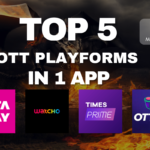OTT Apps and TV Channels Apps have vast Difference in Providing content source, Distribution Model, Content Availability, User Experience, Revenue Model and Geographical Restrictions. Here you will find your required answers about OTT Apps and TV Channels Apps to elaborate and understand well in terms of their working, usage and Functions. Let’s Start the journey to understand well about OTT Apps and TV Channels Apps.
OTT Apps are the Platforms or Apps that provides you the Content in Recorded form where you can easily access those whenever you want to or wherever you want to watch and download. OTT Apps have basically their Subscription Plan to access the content and watch SVOD (Subscription Videos on Demand). OTT Apps are only accessible through Apps in Mobile, TV, Laptops. Some basic OTT Apps in market are Netflix, Prime Video, Disney Plus, Chaupal, and many more.
TV Channel Apps are now becoming modified in 2020 providing you the vast Library of Content on Apps which is accessible through your TV, Laptops, Mobile Devices. TV Channels are live broadcasting event If you access it on your handy devices the Video starts as it is running on TV/Cable. TV Channels needs subscription for streaming according to the Channels charges. Some basic Examples of modified and new TV Channels are YouTube TV, IPTV, Amazon TV, Disney Plus Hotstar and many more in the market.
Content Sources:
TV Channel Apps: Typically, particular TV networks or channels (like NBC, BBC, or Geo TV) offer these apps. The episodes, news, and live TV that are Aired on the network’s TV channel are typically available on these apps as well. Additionally, several TV station apps provide on-demand access to their broadcast programming.
The programming available on over-the-top (OTT) platforms, such as Netflix, Amazon Prime Video, and Disney+, is not limited to any particular TV network. OTT apps frequently offer licensed motion pictures, television shows, documentaries, and unique material that is accessible on-demand. They often don’t offer live programming, unlike TV channel apps (but some do, such Hulu Live or YouTube TV).
Distribution Model:
TV Channel Apps: These applications are add-ons for conventional television services. In order for consumers to access material, especially live TV, they may require a cable or satellite TV subscription. They usually restrict access without a subscription, though they might occasionally offer some free episodes or content.
OTT Applications: OTT applications don’t require a cable or satellite TV subscription because they are supplied directly over the internet. They run on two different business models: subscription (like Netflix and HBO Max) or freemium (like Peacock and Tubi), where users can access material for free in exchange for advertisements. OTT apps circumvent cable distribution and traditional broadcasting.
Content Availability:
TV station Apps: Usually, the material is limited to what the station is airing. Users may only be able to browse the channel’s catalog and may not be able to watch previous episodes or series.
OTT Apps: With a greater library of previous and current television series, films, and exclusive material, OTT platforms provide a broad range of content that is available on demand. Without having to wait for planned airings, users may view complete seasons or movies whenever it’s convenient for them.
User Experience:
TV Channel applications: These applications typically replicate the live TV experience, with scheduled programs and content that corresponds to the current broadcast lineup. Some apps offer on-demand content, but the major focus is on live streaming.
OTT Apps: OTT apps are built for on-demand streaming, with a simple interface that allows users to search for and choose what they want to watch at any time. They frequently incorporate tailored suggestions, downloads for offline viewing, and multi-device syncing.
Revenue Model:
TV Channel Apps: Revenue is often obtained by combining cable/satellite subscriptions and advertising. Some apps may provide paid premium content or ask users to sign in using their cable provider credentials.
OTT Apps: OTT platforms make money largely through subscription fees (SVOD: Subscription Video on Demand), advertisements (AVOD: Ad-supported Video on Demand), or a combination of the two. They frequently provide tiered pricing for different levels of service (for example, HD vs. 4K, ad-free experiences).
Geographical Restrictions:
TV Channel Apps: Geographic constraints due to broadcast rights may limit access to particular regions where the channel is available via cable or satellite providers.
OTT applications: While OTT applications may have geographical constraints, they normally function on a worldwide scale and are available in numerous countries, subject to license agreements.


